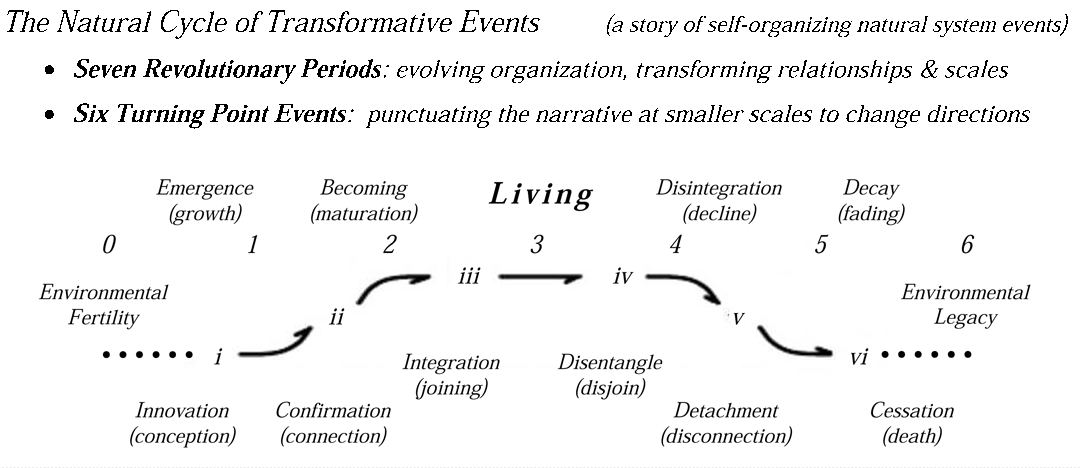
Chapters of a whole event (life):
The canonical succession of self-organization in naturally
occurring systems,
the "beginning to end, whole story" of the origin and
life cycle of organized natural systems as events in time.
JLH HDS systems design science 6/01/09, 9/7/10, 7/25/11, 5/31/13
Chapter 0, Chapter 1, Chapter 2,
Chapter 3, Chapter 4, Chapter 5,
Chapter 6
History curve &Timeline models from others - Spatial Diagrams of Causal Systems - Related topics - Edit Footnotes
Relationship to the
physics complex system change
Natural systems are self-organizing learning processes - applications & discussion
continued in Reading Nature's Signals based on 1990's Theory & Applications of the General Physics
Classic Life cycle of natural system development and decay, alternating bursts and settlings of change
- e.g. traced as for the development of
an energy use event from its beginning to its end
- used to refer to the general succession of necessary phases
of organizational development
- implied by the conservation laws, that it takes a process
to change a process
- used to help
locate & study the periods of complex emergence of change in nature.

Descriptive Notes
continuities exposing nature working by complex organization beyond our view, as implied by energy conservation and found by observation |
Descriptive names
(Building up & Building down) - Maintaining - (Breaking up & Breaking down)
(Divergence & Convergence in growth) - Maturity - (Divergence & Convergence in decline)
(beginning to completing growth) - maturity - (beginning to completing decline)
(multiply searches to filling in the gaps) - stability - (multiply gaps to filling in searches)
(branching out to branching in) - stability - (branching out to branching in)
(foundations to finishes) - use - (dismantling to recycling)
(collect) - transform - (distribute)
(departure & arrival) - resident - (departure & arrival)
(R selected sere to K selected sere) - climax ecology - (R selected sere to K selected sere)
(business start-up to market saturation) - cash cow - (break-up for parts to scrap heap )
Diagram KEY
Chapter#, Highlighted Shape
of Process, Signs of derivative rates d', d'', d''', d''''
| Network graph: | Characterization List |
| a. descriptive | |
| b. energy flow | |
| c. information | |
| d. network type | |
| e. network topology | |
| f. observables | |
| g. exploratory learning stage | |
|
h. business |
Point#, Highlighted
Time of Event,
Illustrative image, Characterizations
Chapter 0.
...![]()
![]()
![]()
![]()
![]() . no
measures 0,0,0,0,... (next, prior)
. no
measures 0,0,0,0,... (next, prior)
Stage 0, Open Environment, accumulation of potentials, "before"
proto-organization forms, the invisible phase, a quiet allowing fragile things to form without perturbation
stable gradient wall, a potential to become tunneled by development of the system, no investment no returns
information unconnected
fragmentary threads
no network definable
no features observable
pre-connection/arousal, dissonance
exceptions
Point I. .|![]()
![]()
![]()
![]()
![]() .
.
Germination/Initiation, the seed of development, venture capital, fertilization, a combination of a non-renewable resource and a germ of organization or design, the "ah ha" moment occurring in an environment of opportunity for it.
 |
|
 |
|
Chapter 1 .![]() |
|![]()
![]()
![]()
![]() .deriv's
all positive
+, +, +, +,... (next, prior)
.deriv's
all positive
+, +, +, +,... (next, prior)
Growth/Gestation, multiply internal frameworks, "Building up" - Immature Development - divergent increase
1st observed as an emerging continuity
regular immature growth explosion, homeorhesisincreasing energy density to size, intensification,
growth, auto-catalysis, increasing EROIincreasing acquisition of information constraints
elaborating self-organizing interior networks,
exploring their fringe, replicating positive returnsnetwork topologies start w/ uniform distrib. (1)
changes of scale without limits, self-organization
branching out, initiation/elaboration, possibly to a point of collapse
seed resource & self-investment, innovation, growing returns invested in expansion
Point II.
.![]() |
|![]()
![]()
![]()
![]() .
.
Scale Transformation Point 1. Birth/Emergence, Connection - reorientation from internal to external environmental relationships and responses
 |
|
 |
|
Chapter 2 .![]() |
|![]()
![]()
![]()
![]() .
deriv's
+, -, -, -, -,... (next, prior)
.
deriv's
+, -, -, -, -,... (next, prior)
Maturation/Integration, Completing internal
relationships, "Building down", Develop external relationships -
(or failure to make the jump)
stabilization & environ. integration, developing independence, or not
energy maximization, efficiency as resource, diminishing rate of returns
information refinement and diversification
network pruning to form hubs diversifying links to exterior, or not
network topologies end w/ inv. power law distrib. (1)
expansion responsive to limits, self-org/adaptation or not
branching in, completion/refinement, maturation
sustainable resource & other-investment, stabilizing returns, diminishing returns for expansion
Point III.
.![]()
![]() |
|![]()
![]()
![]() .
.
Stabilization/Balance, Point of completion, Confirmation of role in destination niche in environment
|
|
|
Chapter 3 .![]()
![]()
![]()
![]()
![]() .
deriv's
+, -, +, -, +,... (next, prior)
.
deriv's
+, -, +, -, +,... (next, prior)
Stage 3, Mature vitality - Continuation, homeostasis, normalizing strain within and without
Stable responsive fluctuation, homeostasis, reproduction
stable energy density flow rate, stable investment & return
Healing exceeds information decay, recovery from perturbations
connections with other networks slowly adapt
network topologies, keeping power law distribution.
limits moving with environments, self-adaptation
participation in larger systems & relations, engagement
service period, integration with community
Point IV.
.![]()
![]()
![]() |
|![]()
![]() .
.
Destabilization/Imbalance - Disconfirmation and loss of role in established niche in environment
 |
|
Chapter 4 .![]()
![]()
![]()
![]() |
|![]() .
deriv's
-, +, +, +, +,... (next, prior)
.
deriv's
-, +, +, +, +,... (next, prior)
Breaking up/Infirmity - Disintegration, divergent decline & senescence
sensitivity to perturbation, unrecoverable gaps in homeostasis and environmental adaptation , aging accelerates
energy flow and efficiency decline, declining investment & returns
information resources insufficient for maintenance, excess information to the point of inflexibility
network begins to loose critical mass or hubs
unknown network statistical features
internal & external connections loosen
disengaging
market succession to other needs
Point IV. .![]()
![]()
![]()
![]() |
|![]() .
.
Scale Transformation Point 2. Disengagement/Disconnection - Point of withdrawal - reorientation from environmental to internal relationships and responses
 |
|
Chapter 5 .![]()
![]()
![]()
![]() |
|![]() .
deriv's -, -, -, -, -,... (next, prior)
.
deriv's -, -, -, -, -,... (next, prior)
Decay - "Breaking down", convergent decline & senescence,
breakdown into separated parts
Energy density flow rate gradually dropping below functional requirements, vanishing investment & returns
unresponsive functions impose information burden
some network remnants reconnect on new paths
unknown network statistical features
withdrawal from environ. draws others into niche
detachment & decay
lingering and shrinking niche
Point VI.
.![]()
![]()
![]()
![]()
![]() |.
|.
Death/Termination - opposite of germination/initiation, disbanding the emergent scale, event that ends the process
 |
|
 |
|
Chapter 6 .![]()
![]()
![]()
![]()
![]() ...
no measures... (next, prior)
...
no measures... (next, prior)
Stage 6, Legacy lingering echoes, "after"
- environmental footprint fades, or used by others, some maintained
- stores and sources become used by others, no energy flow
- environmental niche & system pattern memory fading
- network remnants serve as 'compost' of parts or info
- unknown statistical features or remains
- trails of past effects
- pre-connection/arousal?
1) P Henshaw 1993, 2008 "The physics of change" and "Continuity and divergence theorem"
2) Stan Salthe 1993 Development and Evolution: Complexity and Change in Biology, MIT Press.
3) P Henshaw 1985 Directed Opportunity, Directed Impetus: New tools for investigating autonomous causation, Proceedings, Society for General Systems Research, Louisville KY http://www.synapse9.com/DirOpp.pdf
Numerous Other Topics - could be studied for their characteristics at each of the 6 points and 5 periods of change.
In Network maps, nodes tend to be 'hives' and links to be 'markets' and the form of each evolves with the whole. Mechanism of network includes numerous reciprocating cycles acting as pumps, like self-investment of energy in constructing and driving energy converting parts.
Related Reference Views of punctuated equilibrium as a process:
Connie JG Gersick 1991 "Revolutionary Change Theories: A Multilevel Exploration of the Punctuated Equilibrium Paradigm" The Academy of Management Review, Vol. 16, No. 1 pp. 10-36 http://www.jstor.org/stable/258605
Brown, Shona L. Eisenhardt, Katleen M 1997 The art of continuous change: linking complexity theory and time-paced evolution in relentlessly shifting organizations. Administrative Science Quarterly http://www.encyclopedia.com/doc/1G1-19586840.html
Lyytinen, K., Newman, M. 2006. "Punctuated Equilibrium, Process Models and Information System Development and Change: Towards a Socio-Technical Process Analysis," Case Western Reserve University, USA . Sprouts: Working Papers on Information Systems, 6(1). http://sprouts.aisnet.org/6
Kalle Lyytinen, Mike Newman 2006 "Punctuated Equilibrium, Process Models and Information System Development and Change: Towards a Socio-Technical Process Analysis" http://citeseerx.ist.psu.edu/viewdoc/summary?doi=10.1.1.95.2108
Sweta D. Vajir 2007 "Adaptive Strategic Planning: Punctuated Equilibrium" ICFAI Journal of Business Strategy, Vol. 4, No. 2, pp. 38-46, June 2007 http://papers.ssrn.com/sol3/papers.cfm?abstract_id=1018873
Stuart Kauffman, 2008 Reinventing the Sacred, 1995 At Home in the Universe, (quoted in Nash, 1995) "Soon after a major innovation, discovery of profoundly different variations is easy. Later innovation is limited to modest improvements on increasingly optimized designs"
Kalle Lyytinen and Mike Newman 2008 "Explaining information systems change: a punctuated socio-technical change model" European Journal of Information Systems 17, 589–613 & 2008 Operational Research Society Ltd. All rights reserved 0960-085X/08 www.palgrave-journals.com/ejis/
Ichak Adizes - Adizes Institute, business learning consultants and education - http://www.adizes.com/ publications http://www.adizes.com/products_adizes_books.html
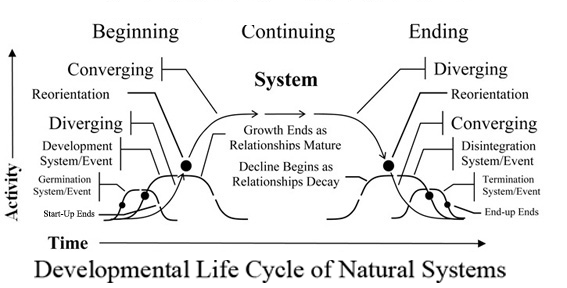
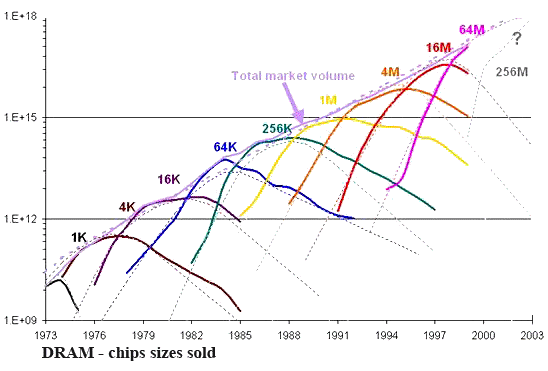
1a Scales of Learning Phases 1b Product Succession Curves
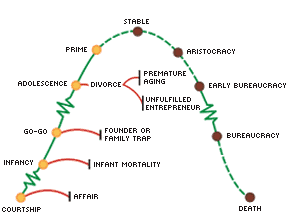
1c. Adizes Business plan development phases
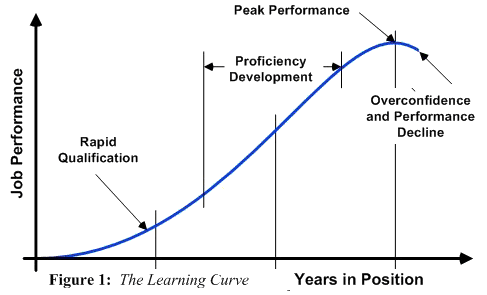
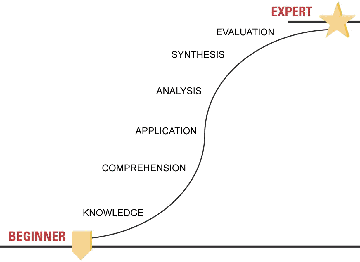
Performance Learning Curves: 2a. On the Job & 2b Expertise

3a Action Learning Diagram
| Timeline Models 6/01/09 | ||||
| 1a | Scales of Learning | Examples | Uses | Key Observations |
 |
||||
| 1b | Product Succession | |||
 |
||||
| 1c | Adizes Business Plan | |||
 |
||||
| 2 | Performance On the Job | |||
 |
||||
| 3a | Expertise Learning | |||
 |
||||
| 4 | Action Learing | |||
 |
||||
9/18/09 There is a basic physics theorem underlying this whole approach to understanding self-organizing (non-deterministic) systems. It connects the observed sequence of natural developmental processes with the requirements of energy conservation for systems of changing scale, expanding to an infinite series of conservation laws to derive a "law of continuity" for organizational change in nature. The proof follows from taking a series of derivatives of the conservation laws and then reintegrating them, and then seeing how the form of the result fits the range of observed development processes. Every energy transfer needs to begin and end without infinite accelerations, and the result is a map of how that could happen, as discussed in notes on the physics of change. Each of the four directions of process feedback are irreversible processes of either divergent and convergent change, prompted by and prompting events on other scales.
Even when you don't observe the whole chain of development, the law of continuity implies a "null hypothesis". Evidence of conserved change, such as changes of state or punctuated equilibria, point to discoverable complex systems of developmental diverging & converging change producing them, along with the environmental gradient they employ as an energy source. Similarly noticing any one of the stages of a life-cycle can lead to discovering the others it is part of. In that way these shapes and their characteristics are used as "pointers" to help unravel the local story of a system development event.
The origin of this model was watching development systems change their entire way of changing, engaging with new environments during an otherwise "seamless and uneventful" point #2 where their accelerations of change reverse. Environmental relationships that had been exhibiting exploding kinds innovation and energy use suddenly switch to exhibiting refinements of design and stabilizing energy use. I eventually realized that also corresponded to the transformational switch in attention and responses from internal to external relationships (#2) and matches the other switch from external to internal relationships (#4). These change of scale moments generally accompany, and may require, periods of distinct calm. It happens SO smoothly, during the growth of every organism, for example, as well as in the middle of every successful project at the office, it's rather mysteriously invisible as the key turning point in every succession of events that results in "conserved change" in environmental organization.
These "Transformation points" when complex systems switch their orientation from internal to external relationships, and from origin to destination environments, also correspond to periods of adding successively bigger unfinished business to taking successively smaller steps toward completing them. For building a house, for example, that point is approximately when the roof goes on, and then successively smaller and smaller finishing tasks are needed to finally complete it before it can be occupied. Those building projects that, for one or another reason, effectively "run out of lumber before putting on the roof", omit their growth transformation point, and never get completed and put into service as a result.